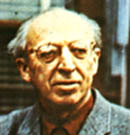

AARON COPLAND
14thNovember 1900 --- 2ndDecember 1990
Copyright 1994-1998 Encyclopaedia Britannica
Last Updated on 2022
By Steven Ritchie
And now for the Music

Thank to Walter Voigt for the music below.
New (3685)"Appalachian Morning". Sequenced by Walter Voigt. Thank to Joseph Robles for the music below. Email (Anchises@aol.com)
(898)"The Promise of Living, from the Tender Land". Sequenced by Joseph Robles (899)"Danza de Jalisco". Sequenced by Joseph Robles (865)"Sunday Traffic, from Music for Movies". Sequenced by Joseph Robles (15a)"Fanfare for the common man". Sequenced by Michael Barrett Thanks to Gary for sequencing and donating the following music below
(479)"Symphony No.3, Mov.1". Sequenced by Gary (485)"Appalacian Spring". Sequenced by Robert.G.Ouellette (486)"Concerto for Clarinet". Sequenced by Matt Harrah New (3684)"How Down". Sequencer Unknown.

If you done any Classical pieces of say for example, Delius, mozart, and so on etc,
please email them to the classical music site with details to
"classical (@) ntlworld.com" written this way to stop spammers
just remove spaces and brackets for email address, thank you.

Visitors to this page --

Back to Classical Midi Main Menu click "HERE"